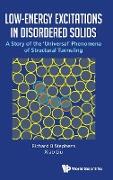- Start
- Low-Energy Excitations in Disordered Solids
Low-Energy Excitations in Disordered Solids
Angebote / Angebote:
The subject of low-energy excitations has evolved since two-level-tunneling systems were first proposed ~50 years ago. Initially they were used to explain the common anomalous properties of oxide glasses and polymers, now the subject includes a wide range of other materials containing disorder: amorphous semiconductors and metals, doped- mixed- and quasi-crystals, surface adsorbates, ... and topics such as dephasing of quantum states and interferometer noise. A fairly simple empirical description using a remarkably small range of parameters serves well to describe the effect of these excitations, but the structures causing these effects are known in only a few materials and the reasons for their similarity across disparate materials has only been qualitatively addressed.This book provides a unified, comprehensive description of tunneling systems in disordered solids suitable for graduate students/researchers wishing an introduction to the field. Its focus is on the tunneling systems intrinsic to glassy solids. It describes the experimental observations of 'glassy' properties, develops the basic empirical tunneling model, and discusses the dynamics changes on cooling to temperatures where direct excitation interactions become important and on heating to where tunneling gives way to thermal activation. Finally, it discusses how theories of glass formation can help us understand the ubiquity of these excitations.The Development of the basic tunneling model is the core of the book and is worked out in considerable detail. To keep the total within bounds of our expertise and the readers' patience, many related experimental and theoretical developments are only sketched out here, the text is heavily cited to allow readers to follow their specific interests in much more depth.
Folgt in ca. 15 Arbeitstagen



